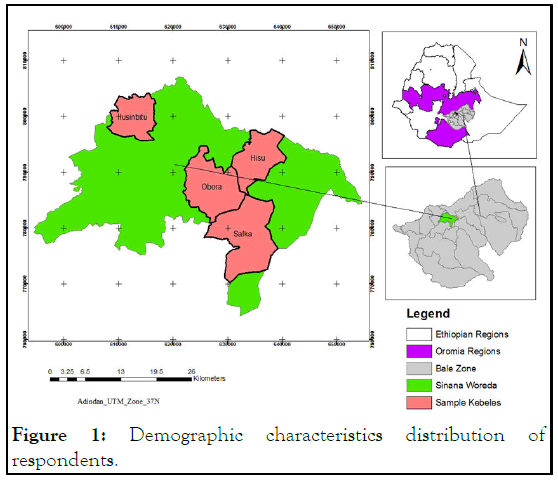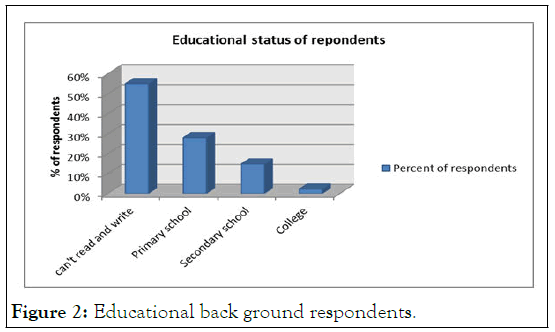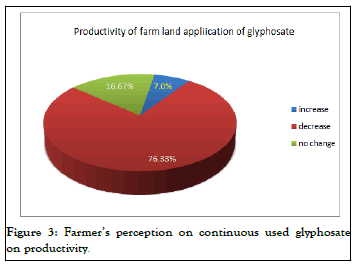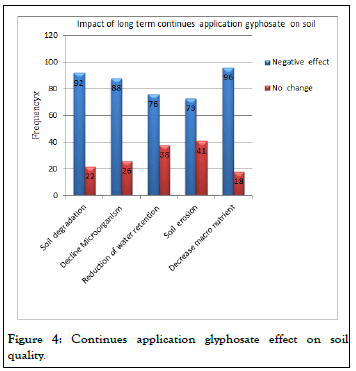Journal of Pollution Effects & Control
Open Access
ISSN: 2375-4397
ISSN: 2375-4397
Research Article - (2025)Volume 13, Issue 2
The agronomic and socioeconomic utilities of glyphosate as a weed killer are well established in developed countries as well as in developing countries; however, our knowledge of the potential effects of glyphosate remains limited. This study was investigated the impact of glyphosate application on soil quality of agricultural land and followed by a survey on farmers’ perception. About 121 household heads were selected using systematic sampling technique, key informants and people for FGD were selected by purposive sampling technique Sinana woreda, south eastern Ethiopia. The qualitative data were analyzed by categorizing in to different thematic areas and narrating. The quantitative data were analyzed by SPSS with Microsoft excel. The result of the study indicated that long term and continues application of glyphosate decreasing the soil quality that decline farmers production and farmers have been not awareness about application of glyphosate. Major challenges mentioned by farmers about application of glyphosate on their farmland were shortage of educated man power, poor farmer’s knowledge about glyphosate and lack of follow up and untimely chemicals supply.Therefore, institutional mechanisms need to be stronger, regular maintenance and implementation of application in line with the recommended standards need attention to increase their effectiveness.
Farmer’s awareness; Glyphosate; Long term application; Sinana woreda
Glyphosate (N-(phosphonomethyl) glycine; C3H8NO5P), a highly efficient broad-spectrum and non-selective herbicide, has been widely used in agriculture, horticulture, parks, and domestic gardens. It was first marketed in 1974 under the name Roundup by Monsanto, USA. Its use has increased rapidly with the commercial introduction of genetically modified corn, soybeans, and cotton; glyphosate-based herbicides have become the most widely applied herbicide worldwide, especially on genetically modified crops [1]. With the intensive use of these kinds of herbicides, the occurrence of glyphosate in soil, sediment and water bodies, as Well as risks to human health. With the expiration of Monsanto’s patent, many other companies began producing relatively inexpensive generic equivalents [2].
After application, herbicides may evaporate (volatilize) and washed away through surface run-off or leached into deep soil strata and ground water, they may be inactivated by plants or adsorbed in soil and become subjected to chemical degradation. Knowledge of soil quality status plays a vital role in enhancing production and productivity of the agricultural sector on sustainable basis, currently only little scientific information is available on the magnitude of soil quality changes under different land uses and crop production system and its management impact pertinent to sustainable crop production. Glyphosate was one of the pesticide chemical, Soil degradation and depletion of soil nutrients are among the major factors threatening sustainable cereal production in the Ethiopian highlands, lack of awareness causes improper and long-term usage of pesticides in farmlands is a critical challenge of soil quality decline [3].
Effects of glyphosate residues in soil when it is applied as a spray in ecological restoration, a situation where the common spray application technology has a risk of high herbicide delivery rate, regardless of whether the concentration used conforms to the label recommendation high delivery volumes will result in runoff from leaves to soil operator error delivering excessive dose rates appears to present the real problem [4]. Glyphosate use in agricultural land has effect on Environmental and ecological to loosen the soil and for favorable seed bed, severe erosion and other additional land degradation. A healthy soil is the base of healthy production makes life longevity and good management is essential to conserve the soil quality. In view of present agricultural methods, intensification of farming should not lead the accumulation of some organic molecules like glyphosate in the soils. Even though the soil quality issue is serious, there is no such research conducted on impact of glyphosate application the formers knowledge and their perceptions in terms of glyphosate application on soil quality in the present study area, which resides in south eastern Ethiopia.
General description of the study area
Location: The study was conducted in Sinanaworedas, Bale zone, and south eastern part of Ethiopia. It is located 430 Km far from the capital city of the country, Addis Ababa. SinanaWoreda is situated between 6.910 to 7.280 latitude and 39.90 to 40.370'E longitude (Figure 1).

Figure 1: Demographic characteristics distribution of respondents.
Sample size determination
For a household survey a number of approaches were used to determine the sample size including; using a census for smaller populations, using published tables, imitating a sample size of similar studies, and applying formulas to calculate a sample size [5]. From several approaches to determine a sample size, this study was applying a formula by Yemane. Determine the required sample size at 91% confidence level, and level of precision (9%). Formula used for calculating a sample size is described as follows.

Where n is the sample size, e is precision level N is the population size, with confidence level of 95% and p=0.5 (maximum variability). Numbers of households was allocated for each sampled kebele based on probability proportional to size of each selected kebeles as indicated.

n=121
Generally, 121 farmers were selected for interview.
Data collection methods
Household survey: A cross sectional household survey was carried out. The questionnaire was assessing demographic characteristics, farmers’ perception on the application of glyphosate on their farm land, impact on soil quality, on their crop production and barriers. Enumerators who can speak the local language fluently were recruited and trend on how to handle mobile data collection devices and questionnaires prior to the data collection exercises. The household survey was conducted on above calculated ‘n’ samples household. Household heads were the respondents for the interview because the household head plays a primary role in the majority of household and farming decisions related to crop production, marketing, resource allocation and adaptation decisions in traditional farming [6]. In order to gain respondents trust, the objectives of the survey and direct and in direct benefits of the study will be carefully informed to the respondents.
Focus group discussion: In this study Field Group Discussion (FGD) was in the four kebeles to sample containing 6-8 people (with separate groups of men, women and youth) who represent the community in their respective kebele and have knowledge of the study sites. The aim of this discussion was to generate information about impact of use glyphosate on soil farm lands, the farmer’s perception in the study area and its impact on crop production. The focus group was limited in number because this method required time to hold the discussion and to handle the difficult task of analyzing and interpreting the information gathered. The focus group discussions took place when the respondents were available and whenever it was convenient for the participants of the group.
Key informants interview: In order to triangulate the collected data from household survey and focus group discussions, key informant interview was conducted. Key informants were interviewed from each kebeles, from the woredas offices expert and one key informant from NGO. The interview was focused on soil quality decline, impacts of glyphosate change on farmers crop production was collected using the key informants [7].
The interviews were conducted with people who have sufficient knowledge about the area and be able to memorize well its historical glyphosate application fate in to soil agricultural. Experts and Model farmers with early on soil pollution protection and crop production backgrounds in the woreda and kebeles were interviewed.
Data analysis: The collected data from household questionnaire survey was entered and analyzed using Statistical Package for Social Science (SPSS) version 20.0 software and descriptive tools such as tables, graph, chart, frequency and percentages were employed to present results. Additionally, data acquired by the key informant’s interview, focus group discussions, was analyzed through, opinion interpretations after sorted out; also a narrative analysis was used after organizing data under themes.
This chapter included result and a detailed discussion corresponding to the impact of glyphosate on agricultural soil quality by applying different doses followed by a survey on the formers perception and knowledge respectively.
Demographic characteristics of respondents
Of the total households included in the survey Table 1, the majority 89.25% were male-headed households while 10.75% were female-headed households. With regard to the age structure, the majority 43.8% of the respondents were between 36-45 years old, followed by 28.93% of respondents aged above 45 [8].The respondents are between 26-35 years old accounts for 20.66% of the sampled households, and only 6.61% of the respondents were between 15-25 years old. This indicates that most of the population of this study is in productive age category.
| Demographic characteristics | Frequency | Percentage | |
|---|---|---|---|
| Gender | Male | 108 | 89.25 |
| Female | 13 | 10.75 | |
| Total | 121 | 1 | |
| Age | 15-25 | 8 | 6.61 |
| 26-35 | 25 | 20.66 | |
| 36-45 | 53 | 43.8 | |
| >45 | 35 | 28.93 | |
| Total | 121 | 1 | |
| Marital status | Single | 11 | 9.09 |
| Married | 99 | 81.82 | |
| Widowed | 5 | 4.13 | |
| Divorced | 6 | 4.96 | |
| Total | 121 | 1 | |
| House hold size | 0-2 | 10 | 8.26 |
| 3-5 | 35 | 28.93 | |
| 6-10 | 74 | 61.15 | |
| >10 | 2 | 1.66 | |
| Total | 121 | 1 | |
Table 1: Demographic characteristics distribution of respondents.
The majority 81.82% of respondents were married. About 9.09%, 4.13% and 4.96% of respondents were single, divorced, and widowed household heads respectively, since they were directly involved for controlling of weeds because they were majorly depended on agricultural to sustain. Table 1 also depicts the size of the households per family.
From the total surveyed respondents, 61.15% of them had a family size of six to ten children. About 28.93% of the respondents had a family size between three to five children. 8.26% of the sampled households had a family size between 0 and 2. Only 1.66% of the sampled households had a family size above ten [9]. Educational status of the community influences household decisions, which determines the wellbeing of the community. These factors affect health income and their outlook towards application of glyphosate farm land (Figure 2).

Figure 2: Educational back ground respondents.
Show 55% of the sampled households were uneducated. The percentages of respondents who attended primary school (grade 1-8) secondary school (grade 9-12) and college were 28.09%, 14.87%, 2.49%, respectively. Since, the educational levels are low among the communities in the present study area.
A low level of education among farmers hampered their ability to follow the hazard warnings provided by the chemical industry and regulatory agencies.
Ownership of lands and its size
Since the present study area is agricultural based and most of the individuals depend on the land for their food and income. All the respondents in study area have their own farm lands, this indicates that the study areas was cultivated land, the significant proportion i.e. 83% of the respondents owned less than two hectares of land. About 9% of household heads controlled between 2.1 and 4 hectares of land. Not more than 5% of the sample households owned between 4.1 and 10 hectares of land. Only 3% of the sample households owned above ten hectors. This means that there is an acute shortage of land in the study area, which inhibits the farmer’s ability to produce an adequate amount of crops to nourish the fast-growing population [10]. The CSA indicated that 80% of Ethiopian farmers in high lands cultivate a land which will less than one hectare. As increasing rural population overtime, the number of households with no or small landholdings also increase due to limited land resources. As questionnaire survey show out of 121 respondents 90.08%, 4.96%, 3.3%, 1.66% farmers, businessman religion leader and public servant respectively. Over all, the study area dominated by farmers and major income depended on agricultural activity (Table 2).
| Item | Option | Frequency | Percentage |
|---|---|---|---|
| Occupation | Farmer | 109 | 90.08 |
| Business man | 6 | 4.96 | |
| Religion leader | 4 | 3.3 | |
| Public servant | 2 | 1.66 | |
| Total | 121 | 1 | |
| Land holding | Yes | 121 | 100 |
| No | - | - | |
| Total | 121 | 1 | |
| Size of farm land | Less than 2 ha | 76 | 62.8 |
| 2.1-4 ha | 22 | 18.18 | |
| 4.1-6 ha | 15 | 12.4 | |
| Above 6 ha | 8 | 6.62 | |
| Total | 121 | 1 |
Table 2: Land holding and farm size distribution of sampled of respondents.
Knowledge of the respondents on glyphosate purpose, dosage and brand
As described in Table 3, 94.21% of the respondents were used glyphosate on their farm land to control weeds. In the case of procurement of herbicide, out of 121 respondents, 85.96% were purchased glyphosate herbicide directly from open market and 14.04% respondents were purchased from pesticide killer shop. This revealed that, the farmers especially in the study area are not purchasing glyphosate pesticide from government agents. This indicates that the glyphosate was not selling professionally/ legally; the seller and the end user have the same knowledge about the properties of the glyphosate chemical. Similar studies were done on pesticide pollution has become a great challenge for the sustainable development of agriculture.
Regarding dosage of glyphosate application, 79.82% of the respondents were applied over dosage of glyphosate on their farm lands. Only 15.79% of the respondents were followed and applied as company recommendation. The reaming 4.39% of the respondents were used the glyphosate on their farm land under dose. It seems that the farmer doesn’t have minimum knowledge on dosage of glyphosate per hector [11]. Inappropriate farming practices and overuse of pesticides on cultivated land has resulted on-site pollution problems. As the households questionnaire show all of them applied to their farm land once per year.
| Option | Frequency | Percentage | |
|---|---|---|---|
| Use of glyphosate | Yes | 114 | 94.21 |
| No | 7 | 5.79 | |
| Total | 121 | 1 | |
| Place of purchasing glyphosate | Open market | 98 | 85.96 |
| Pesticide vendor shop | 16 | 14.04 | |
| Government | - | - | |
| Total | 114 | 1 | |
| Applied per hector | 1 L/ha | 5 | 4.39 |
| 2.5 L/ha | 18 | 15.79 | |
| 3 L/ha | 68 | 79.82 | |
| Total | 121 | 1 | |
| Replication of application per year | Once | 114 | 1 |
| Twice | - | - | |
| Three times | - | - | |
| Total | 114 | 1 |
Table 3: Knowledge of respondent’s purpose, dosage and frequency of application.
The safe use of glyphosate and period of storage before application
Out of the 121 respondents, 114 respondents were used glyphosate and 82% of the farmers in study area admitted that they trusted their own experience of application rather than following the specifications on the labels of glyphosate containers. 15% of the respondents were got information from pesticide shop vendors and only 3% of the respondents followed instruction on the labels of pesticide containers. According to the survey, farmers had only little basic information about glyphosate herbicides sprayer and residues. Thought that pesticides could affect environmental quality, most farmers did not clearly understand about the effect of the glyphosate chemical [12] claimed that adequate and reliable sources of information seemed to induce the perception of risk and the adoption of preventive measures, despite the low general level of education of the subjects involved. All the respondents, who used glyphosate were applied immediately without storage, it seems that glyphosate may not expired before usage (Table 4).
| Question | Variables | Frequency | Percent |
|---|---|---|---|
| For how much period of time you stored before application | Immediately | 114 | 1 |
| For a year | - | - | |
| For two year | - | - | |
| For three year | - | - | |
| Total | 114 | 1 | |
| How do you get information for application | Own experience | 94 | 0.82 |
| From vendors | 16 | 0.15 | |
| From government office | - | - | |
| Flow specification | 4 | 0.03 | |
| Total | 114 | 100 |
Table 4: The safe use of glyphosate and period of storage before application in the study area.
The usage of glyphosate for controlling weeds and it price
From Figure 3, as per farmer’s perception, 76.33% respondents were agreed with continuous application of glyphosate decreases the soil quality, 16.67% respondents were disagreed i.e. continuous application of glyphosate increases the soil quality and increases the crop production. 7% of respondents revealed that there is no effect on soil quality by applying glyphosate. The application of organophosphate herbicides affects the size and composition of these organisms decrease the soil productivity functions.

Figure 3: Farmer’s perception on continuous used glyphosate on productivity.
Farmer’s perception on continuous application of glyphosate on agricultural soil quality
As a below Figure 4 showed that glyphosate is sensitive chemical in soil. It build up toxic effect and endure for decade, it reduces organic matter, water retention capacity, and fertility. The activity of biomass is drastically affected in the soil. As survey results show continuous application and long term application had negative effect on soil microorganism, nutrient decline lead soil erosion soil degradation and water reduction from soil, 77.19%, 84.21%, 64.03%, 80.07% and 66.66% respectively. This indicates microorganism is the most crucial for protecting soil quality as chemical applied continuous the microorganism affect by chemical and unquestionable for decline of soil quality status. Glyphosate has been reported to alter soil microbial communities, for example to decrease the population of arbuscular mycorrhizal fungi, which facilitates nutrient uptake from the plant roots [13].

Figure 4: Continues application glyphosate effect on soil quality.
The discussions held with the focus groups and the interview conducted with model farmers, woreda agricultural expert/NGO expert.
As one of the model former key informant stated that, when he applied the glyphosate for the first time, observed that there is no change in the production. When he started continues application of glyphosate, observed that decreasing in production. It evidenced that continues application of glyphosate reduces the crop yield According to ‟ NGO” key informant, Weed management is a big challenge in agriculture and in many cases it’s a complex, controversial and expensive problem to resolve. In order to protect soil fertility, ecosystem services as well as environmentally, there is a clear need to reduce and gradually overcome our dependency to herbicides and other such chemicals. The key is investing in sustainable agriculture systems for proper practices, instead of avoiding exhaustion and destruction of natural resources, but also at the appointed time an ecologically viable agricultural production model [14]. “Sheep weeders” are becoming more popular in different parts of the world due to their low cost compared to glyphosate application of glyphosate. Sheep grazing can be beneficial in vineyards not just for removing the weeds, but also because sheep dung is a good fertilizer for the soil. From the survey, it was observed that farmers were applied glyphosate on the farm land because ploughing with the glyphosate to clear the weeds in short period of time. This serious destruction of soil minerals resources without replacement led to the hindrance of generation capacity of soil species in natural land. Additionally, the usage of glyphosate increase from time to time [15]. Due to lack of knowledge and illiteracy, further intensified by without considering its negative impact they are only concentrated on the easy removal of weeds through application of glyphosate. Thus, there was high soil erosion and decline in soil fertility because of destruction of soil which in turn led to relatively lower agricultural yields. From the above findings, one can infer that the overall impacts of application glyphosate causes decline in soil fertility and thereby decline in land productivity with reduced farm income which directly affects the livelihood of rural population in the study area.
Improper application of Pesticide on agricultural land is one of the major environmental concerns that adversely affect livelihoods. Continuous application of glyphosate, long term impact to soil quality soil erosion, degradation, decline of nutrients. This study was targeted to assess impact of glyphosate on agricultural soil quality in selected kebeles of Sinana wereda, Bale zone, south eastern Ethiopia. Hence, the main findings of the research are summarized below. From over all study, that the researcher concluded that; there was a lack of knowledge on application of glyphosate in the study area. The long term application of glyphosate may leads decline of soil fertility; this further decreases the crop yield. According to survey results the continuous intensive application of glyphosate area without appropriate soil management has affected most of the important soil characteristics. Therefore, reducing intensive glyphosate in control weed, and integrated use of glyphosate practices could replenish the soil characteristics for sustainable agricultural production and productivity in the study area.
The following recommendations are important and need to be considered to enjoy more effects by addressing the constraints of the farmers.
• There is a need to strengthen the scientific basis of modern
agriculture, because herbicides may be useful if their
persistence, bioaccumulation, and toxicity in agro-ecosystem
are strictly controlled.
• Government should create awareness on usage of glyphosate
herbicide to farmers on agricultural farm with respect to both
short and long term effect.
• Agricultural Development Project (ADP), stake holders and
governments conducted organize training for rural farmers on
application of herbicides and farmers should form
associations so as to pull resources together, buy herbicides
directly from the distributors.
• The investigator was not conducted on health impact the
sprayers, so further studies need to be conducted on problems
of human health.
[Crossref] [Google Scholar] [PubMed]
[Crossref] [Google Scholar] [PubMed]
[Crossref] [Google Scholar] [PubMed]
[Crossref] [Google Scholar] [PubMed]
[Crossref] [Google Scholar] [PubMed]
[Crossref] [Google Scholar] [PubMed]
[Crossref] [Google Scholar] [PubMed]
[Crossref] [Google Scholar] [PubMed]
Citation: Saraswathi M, Guye TK, Nigussie T (2024) Farmer’s Perception, Knowledge, Continuous Application of Glyphosate in Agricultural Soil Quality in the Sinana Woreda, South Eastern Ethiopia. J Pollut Eff Cont. 12:404.
Received: 19-May-2020, Manuscript No. JPE-24-4293; Editor assigned: 22-May-2020, Pre QC No. JPE-24-4293 (PQ); Reviewed: 05-Jun-2020, QC No. JPE-24-4293; Revised: 15-May-2024, Manuscript No. JPE-24-4293 (R); Published: 12-Jun-2024 , DOI: 10.35248/2375-4397.25.13.426
Copyright: © 2024 Saraswathi M, et al. This is an open-access article distributed under the terms of the Creative Commons Attribution License, which permits unrestricted use, distribution, and reproduction in any medium, provided the original author and source are credited.